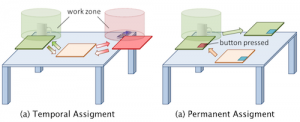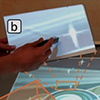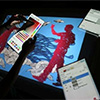Graphics editors often suffer from a large number of tool palettes that compete with valuable document space. To address this problem and to bring back physical affordances similar to a painter’s palette, we propose to augment a digital tabletop with spatially tracked handheld displays. These displays are dynamically updated depending on their spatial location. We introduce the concept of spatial Work Zones that take up distinct 3D regions above the table surface and serve as physical containers for digital content that is organized as stacks of horizontal layers. Spatial Work Zones are represented either by physical objects or on-screen on the tabletop. Associated layers can be explored fluently by entering a spatial Work Zone with a handheld display. This provides quick access and seamless changes between tools and parts of the document that are instantly functional, i.e., ready to be used by a digital pen. We discuss several use cases illustrating our techniques and setting them into context with previous systems. Early user feedback indicates that combining dynamic GUI functionality with the physicality of spatially tracked handheld displays is promising and can be generalized beyond graphics editing.
The TUIP Concept
The concept of Tangible User Interface Palettes (TUIP) is based on the traditional painter’s metaphor, where a painter uses real-world tools like brushes and color palettes that are physically separated from the painting. With TUIP, we apply this idea to a digital tabletop. The tabletop screen shows graphics documents that users can edit by using digital pen input. While tools (e.g., in form of menus) and the graphics document usually share the same screen space, we propose to decouple this space by making digital tool palettes physically tangible. We achieve this by using spatially aware handheld displays (Tangible UI Palettes) in different sizes and shapes that serve as physical representations for the otherwise virtual palettes. Users can take them into their hands and move and arrange them freely in 3D space and work with them using digital pen input. Thus, they bring back some of the advantages of a 3D work environment known from the analog world.

Principle TUIP components: a tabletop with a graphics document (a), a handheld display with a detail view of that document (b), and handheld displays with tool menus (c). All displays are digital pen-enabled (d). Spatial work zones (e, f) are used as physical containers that can hold tools or document. They are represented by tangible proxies (e) or on-screen (f).
Spatial Work Zones
We propose to extend the interaction with spatially aware tangible displays by using proxemic interaction principles. We do this by introducing the concept of spatial Work Zones that are distinct spatial 3D regions above and around the table with individual spatial positions and extensions. They define an independent interaction space that can be explored by moving handheld displays into and through them. This either temporarily or permanently changes what is displayed on a handheld display. In this way, spatial work zones serve as physical containers that we use for pooling related functionality or digital content.

Spatial Work Zones are spatially bounded regions above and beside the tabletop. They provide fast access to tool palettes and documents. Moving a handheld display into them instantly changes what is shown on the display. Leaving the Work Zone immediately restores the previous content (a). Pressing a special on-display button makes the change permanent (b). This allows for taking along a particular tool palette when leaving the Work Zone.
Publications
@inproceedings{2013_spindler_TUIP,
author = {Martin Spindler and Victor Cheung and Raimund Dachselt},
title = {Dynamic Tangible User Interface Palettes.},
booktitle = {Proceedings of INTERACT 2013},
year = {2013},
month = {9},
location = {Cape Town, South Africa},
pages = {159--176},
numpages = {18}
}List of additional material
@inproceedings{fixme,
author = {Martin Spindler and Michel Hauschild and Raimund Dachselt},
title = {Towards Making Graphical User Interfaces Tangible},
booktitle = {Proceedings of the ACM International Conference on Interactive Tabletops and Surfaces 2010},
series = {ITS '10},
year = {2010},
month = {11},
isbn = {978-1-4503-0399-6},
location = {Saarbr\"{u}cken, Germany},
pages = {291--292},
numpages = {2},
doi = {10.1145/1936652.1936721},
url = {http://doi.acm.org/10.1145/1936652.1936721},
acmid = {1936721},
publisher = {ACM},
address = {New York, NY, USA},
keywords = {digital paper, multi-surface UI, tangible UI}
}List of additional material


